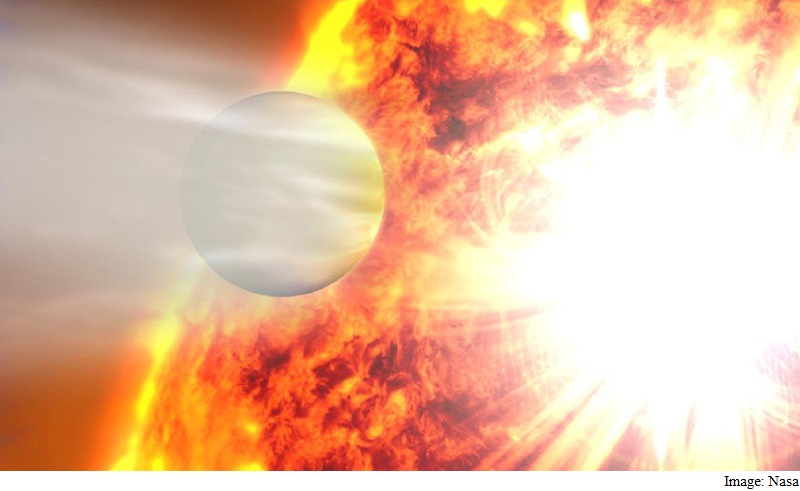- Home
- Science
- Science News
- Planet With Eccentric Orbit Spotted
Planet With Eccentric Orbit Spotted

In this case, "eccentric" doesn't refer to a state of mind, but instead describes how elliptical a planet's orbit is around its star.
While the planets in our solar system have nearly circular orbits, astronomers have discovered several extrasolar planets with highly elliptical or eccentric orbits.
The extrasolar planet HD 20782 has the most eccentric orbit known, measured at an eccentricity of .96, according to the researchers.
This means that the planet moves in a nearly flattened ellipse, traveling a long path far from its star and then making a fast and furious slingshot around the star at its closest approach.
At the furthest point in its orbit, the planet is separated from its star by 2.5 times the distance between the Sun and Earth.
At its closest approach, it ventures as close as .06 of that same Earth-Sun distance much closer than Mercury orbits the Sun, said Kane, an assistant professor of physics and astronomy.
"It's around the mass of Jupiter, but it's swinging around its star like it's a comet," said lead researcher Stephen Kane, assistant professor of physics and astronomy at San Francisco State University in the US.
The findings appeared online in The Astrophysical Journal.
The researchers were able to detect a signal of reflected light from the planet known a "flash" of starlight bouncing off the eccentric planet's atmosphere as it made its closest orbital approach to its star.
By studying the reflected light from HD 20782, astronomers may learn more about the structure and composition of a planetary atmosphere that can withstand a brief but blistering exposure to its star.
The reflected light could tell researchers more about how the atmosphere of a planet like HD 20782 responds when it spends most of its time far away from its star, "but then has a very close approach where it's flash-heated by the star," Kane said.
Kane and his colleagues were able to confirm its extreme eccentricity and the rest of its orbital parameters as part of the Transit Ephemeris Refinement and Monitoring Survey (TERMS), a project led by Kane to detect extrasolar planets as they pass in front of their stars.
Using these new parameters to time their observations, the scientists also used a satellite-based telescope to collect light data from the planet as it orbited closest to its star.
For the latest tech news and reviews, follow Gadgets 360 on X, Facebook, WhatsApp, Threads and Google News. For the latest videos on gadgets and tech, subscribe to our YouTube channel. If you want to know everything about top influencers, follow our in-house Who'sThat360 on Instagram and YouTube.
- AI
- iPhone 16 Leaks
- Apple Vision Pro
- Oneplus 12
- iPhone 14
- Apple iPhone 15
- OnePlus Nord CE 3 Lite 5G
- iPhone 13
- Xiaomi 14 Pro
- Oppo Find N3
- Tecno Spark Go (2023)
- Realme V30
- Best Phones Under 25000
- Samsung Galaxy S24 Series
- Cryptocurrency
- iQoo 12
- Samsung Galaxy S24 Ultra
- Giottus
- Samsung Galaxy Z Flip 5
- Apple 'Scary Fast'
- Housefull 5
- GoPro Hero 12 Black Review
- Invincible Season 2
- JioGlass
- HD Ready TV
- Laptop Under 50000
- Smartwatch Under 10000
- Latest Mobile Phones
- Compare Phones
- iQOO Z9x
- iQOO Z9
- HMD Pulse
- HMD Pulse+
- HMD Pulse Pro
- Realme Narzo 70x 5G
- Realme Narzo 70 5G
- Samsung Galaxy C55
- Lenovo IdeaPad Pro 5i
- Asus ZenBook Duo 2024 (UX8406)
- Realme Pad 2 Wi-Fi
- Redmi Pad Pro
- boAt Storm Call 3
- Lava ProWatch Zn
- Samsung Samsung Neo QLED 8K Smart TV QN800D
- Samsung Neo QLED 4K Smart TV (QN90D)
- Sony PlayStation 5 Slim Digital Edition
- Sony PlayStation 5 Slim
- Lloyd 1.5 Ton 3 Star Inverter Split AC (GLS18I3FOSEW)
- Haier 1.5 Ton 3 Star Triple Inverter Split AC (HSU18K-PYSS3BN-INV)












